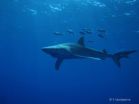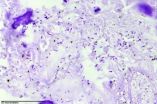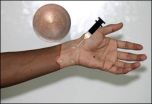(Press-News.org) The origins of mummification may have started in ancient Egypt 1,500 years earlier than previously thought, according to a study published August 13, 2014 in the open-access journal PLOS ONE by Stephen Buckley from University of York and colleagues from Macquarie University and University of Oxford.
Previous evidence suggests that between ~4500 B.C. and 3100 B.C., Egyptian mummification consisted of bodies desiccating naturally through the action of the hot, dry desert sand. The early use of resins in artificial mummification has, until now, been limited to isolated occurrences during around 2200 BC, becoming more frequent between 2000-1600 BC.
Researchers studying funerary textiles from bodies in tombs in one of the earliest recorded ancient Egyptian cemeteries, ~ 4500 B.C. – 3350 B.C, found the presence of complex embalming agents in linen wrappings. Scientists used biochemical analysis to identify a pine resin, an aromatic plant extract, a plant gum/sugar, a natural petroleum source, and a plant oil/animal fat in the funerary wrappings.
These results suggest that embalming agents may have been used up to a millennium earlier than previously thought. The agents constitute complex, processed recipes of the same natural products, in similar proportions, as those employed at the zenith of Pharaonic mummification some 3,000 years later.
Dr Buckley said: "The antibacterial properties of some of these ingredients and the localised soft-tissue preservation that they would have afforded lead us to conclude that these represent the very beginnings of experimentation that would evolve into the mummification practice of the Pharaonic period."
Dr Buckley added: "These resinous recipes applied to the prehistoric linen wrapped bodies contained antibacterial agents, used in the same proportions employed by the Egyptian embalmers when their skill was at its peak, some 2500-3000 years later."
INFORMATION:
Adapted by PLOS ONE from release provided by David Garner.
In your coverage please use this URL to provide access to the freely available paper: http://dx.plos.org/10.1371/journal.pone.0103608
Citation: Jones J, Higham TFG, Oldfield R, O'Connor TP, Buckley SA (2014) Evidence for Prehistoric Origins of Egyptian Mummification in Late Neolithic Burials. PLoS ONE 9(8): e103608. doi:10.1371/journal.pone.0103608
Funding: Support for this research has been provided by: Professor Joann Fletcher and Pharos Research (SAB); The Wellcome Trust (Grant Number WT074315) (SAB); The National Endowment for Science Technology and the Arts (NESTA) (SAB); and Macquarie University (JJ). The funders had no role in study design, data collection and analysis, decision to publish, or preparation of the manuscript.
Competing Interests: The authors have declared that no competing interests exist.
Embalming study 'rewrites' chapter in Egyptian history
Mummification found in Egypt 1,500 years earlier than previously thought
2014-08-13
ELSE PRESS RELEASES FROM THIS DATE:
Little penguins forage together
2014-08-13
Most little penguins may search for food in groups, and even synchronize their movements during foraging trips, according to a study published August 13, 2014 in the open-access journal PLOS ONE by Maud Berlincourt and John Arnould from Deakin University in Australia.
Little penguins are the smallest penguin species and they live exclusively in southern Australia, New Zealand, and the Chatham Islands, but spend most of their lives at sea in search of food. Not much is known about group foraging behavior in seabirds due to the difficulty in observing their remote feeding ...
Young blue sharks use central North Atlantic nursery
2014-08-13
Blue sharks may use the central North Atlantic as a nursery prior to males and females moving through the ocean basin in distinctly different patterns, according to a study published August 13, 2014 in the open-access journal PLOS ONE by Frederic Vandeperre from University of the Azores, Portugal, and colleagues.
Shark populations typically organize by location and separate by sex and size, but these patterns remain poorly understood, particularly for exploited oceanic species such as the blue shark. The authors of this study employed a long-term electronic tagging experiment ...
Bacterial biosurgery shows promise for reducing the size of inoperable tumors
2014-08-13
Kansas City, MO. — Deep within most tumors lie areas that remain untouched by chemotherapy and radiation. These troublesome spots lack the blood and oxygen needed for traditional therapies to work, but provide the perfect target for a new cancer treatment using bacteria that thrive in oxygen-poor conditions. Now, researchers have shown that injections of a weakened version of one such anaerobic bacteria -- the microbe Clostridium novyi -- can shrink tumors in rats, pet dogs, and a human patient.
The findings from BioMed Valley Discoveries and a nationwide team of collaborators ...
Embalming study 'rewrites' key chapter in Egyptian history
2014-08-13
Researchers from the Universities of York, Macquarie and Oxford have discovered new evidence to suggest that the origins of mummification started in ancient Egypt 1,500 years earlier than previously thought.
The scientific findings of an 11-year study by a researcher in the Department of Archaeology at York, and York's BioArCh facility, and an Egyptologist from the Department of Ancient History at Macquarie University, push back the origins of a central and vital facet of ancient Egyptian culture by over a millennium.
Traditional theories on ancient Egyptian mummification ...
Injected bacteria shrink tumors in rats, dogs and humans
2014-08-13
A modified version of the Clostridium novyi (C. noyvi-NT) bacterium can produce a strong and precisely targeted anti-tumor response in rats, dogs and now humans, according to a new report from Johns Hopkins Kimmel Cancer Center researchers.
In its natural form, C. novyi is found in the soil and, in certain cases, can cause tissue-damaging infection in cattle, sheep and humans. The microbe thrives only in oxygen-poor environments, which makes it a targeted means of destroying oxygen-starved cells in tumors that are difficult to treat with chemotherapy and radiation. The ...
Treatment with lymph node cells controls dangerous sepsis in animal models
2014-08-13
An immune-regulating cell present in lymph nodes may be able to halt severe cases of sepsis, an out-of-control inflammatory response that can lead to organ failure and death. In the August 13 issue of Science Translational Medicine, a multi-institutional research team reports that treatment with fibroblastic reticular cells (FRCs) significantly improved survival in two mouse models of sepsis, even when delivered after the condition was well established. Even after treatment with antibiotics, sepsis remains a major cause of death.
"Our findings are important because, ...
Stimuli-responsive drug delivery system prevents transplant rejection
2014-08-13
Boston, MA – Following a tissue graft transplant—such as that of the face, hand, arm or leg—it is standard for doctors to immediately give transplant recipients immunosuppressant drugs to prevent their body's immune system from rejecting and attacking the new body part. However, there are toxicities associated with delivering these drugs systemically, as well as side effects since suppressing the immune system can make a patient vulnerable to infection.
A global collaboration including researchers from Brigham and Women's Hospital (BWH); Institute for Stem Cell Biology ...
Statistical model predicts performance of hybrid rice
2014-08-13
RIVERSIDE, Calif. — Genomic prediction, a new field of quantitative genetics, is a statistical approach to predicting the value of an economically important trait in a plant, such as yield or disease resistance. The method works if the trait is heritable, as many traits tend to be, and can be performed early in the life cycle of the plant, helping reduce costs.
Now a research team led by plant geneticists at the University of California, Riverside and Huazhong Agricultural University, China, has used the method to predict the performance of hybrid rice (for example, the ...
Story ideas from NCAR: Seasonal hurricane forecasts, El Niño, wind energy, and more
2014-08-13
BOULDER – Researchers at NCAR and partner organizations are making significant headway in predicting the behavior of the atmosphere on a variety of fronts, including:
improving weather forecasts
advancing renewable energy capabilities
helping satellites avoid space debris
estimating the risk of a crop slowdown due to climate change
These advances are summarized in short online features now published each week on our AtmosNews website: http://www.ucar.edu/atmosnews.
To get a jump on stories about new research, we invite you to sign up for our concise weekly ...
Single gene controls jet lag
2014-08-13
LA JOLLA–Scientists at the Salk Institute for Biological Studies have identified a gene that regulates sleep and wake rhythms.
The discovery of the role of this gene, called Lhx1, provides scientists with a potential therapeutic target to help night-shift workers or jet lagged travelers adjust to time differences more quickly. The results, published in eLife, can point to treatment strategies for sleep problems caused by a variety of disorders.
"It's possible that the severity of many dementias comes from sleep disturbances," says Satchidananda Panda, a Salk associate ...
LAST 30 PRESS RELEASES:
Norbert Holtkamp appointed director of Fermi National Accelerator Laboratory
New agentic AI platform accelerates advanced optics design
Biologists discover neurons use physical signals — not electricity — to stabilize communication
Researchers discover that a hormone can access the brain by hitchhiking
University of Oklahoma researcher awarded funding to pursue AI-powered material design
Exploring how the visual system recovers following injury
Support for parents with infants at pediatric check-ups leads to better reading and math skills in elementary school
Kids’ behavioral health is a growing share of family health costs
Day & night: Cancer disrupts the brain’s natural rhythm
COVID-19 vaccination significantly reduces risk to pregnant women and baby
The role of vaccination in maternal and perinatal outcomes associated with COVID-19 in pregnancy
Mayo Clinic smartwatch system helps parents shorten and defuse children's severe tantrums early
Behavioral health spending spikes to 40% of all children’s health expenditures, nearly doubling in a decade
Digital cognitive behavioral treatment for generalized anxiety disorder
Expenditures for pediatric behavioral health care over time and estimated family financial burden
Air conditioning in nursing homes and mortality during extreme heat
The Alps to lose a record number of glaciers in the next decade
What makes a good proton conductor?
New science reporting guide published for journalists in Bulgaria
New international study reveals major survival gaps among children with cancer
New science reporting guide published for journalists in Turkey
Scientists develop a smarter mRNA therapy that knows which cells to target
Neuroanatomy-informed brain–machine hybrid intelligence for robust acoustic target detection
Eight SwRI hydrogen projects funded by ENERGYWERX
The Lundquist Institute and its start-up company Vitalex Biosciences Announces Strategic Advancement of Second-Generation fungal Vaccine VXV-01 through Phase 1 Trials under $40 Million Competitive Con
Fine particles in pollution are associated with early signs of autoimmune disease
Review article | Towards a Global Ground-Based Earth Observatory (GGBEO): Leveraging existing systems and networks
Penn and UMich create world’s smallest programmable, autonomous robots
Cleveland researchers launch first major study to address ‘hidden performance killer’ in athletes
To connect across politics, try saying what you oppose
[Press-News.org] Embalming study 'rewrites' chapter in Egyptian historyMummification found in Egypt 1,500 years earlier than previously thought




